Cover
Half-title
Title
Copyright
Contents
Foreword to the first edition
Preface to the second edition
Our motivation for (re)writing this book
What’s new and what’s gone
The interdependence of chapters and prerequisites
Acknowledgements
Added for second edition
1 Propositional logic
1.1 Declarative sentences
1.2 Natural deduction
1.2.1 Rules for natural deduction
1.2.2 Derived rules
1.2.3 Natural deduction in summary
1.2.4 Provable equivalence
1.2.5 An aside: proof by contradiction
1.3 Propositional logic as a formal language
1.4 Semantics of propositional logic
1.4.1 The meaning of logical connectives
1.4.2 Mathematical induction
1.4.3 Soundness of propositional logic
1.4.4 Completeness of propositional logic
1.5 Normal forms
1.5.1 Semantic equivalence, satisfiability and validity
1.5.2 Conjunctive normal forms and validity
1.5.3 Horn clauses and satisfiability
1.6 SAT solvers
1.6.1 A linear solver
1.6.2 A cubic solver
1.7 Exercises
1.8 Bibliographic notes
2 Predicate logic
2.1 The need for a richer language
2.2 Predicate logic as a formal language
2.2.1 Terms
2.2.2 Formulas
2.2.3 Free and bound variables
2.2.4 Substitution
2.3 Proof theory of predicate logic
2.3.1 Natural deduction rules
2.3.2 Quantifier equivalences
2.4 Semantics of predicate logic
2.4.1 Models
2.4.2 Semantic entailment
2.4.3 The semantics of equality
2.5 Undecidability of predicate logic
2.6 Expressiveness of predicate logic
2.6.1 Existential second-order logic
2.6.2 Universal second-order logic
2.7 Micromodels of software
2.7.1 State machines
2.7.2 Alma – re-visited
2.7.3 A software micromodel
2.8 Exercises
2.9 Bibliographic notes
3 Verification by model checking
3.1 Motivation for verification
3.2 Linear-time temporal logic
3.2.1 Syntax of LTL
3.2.2 Semantics of LTL
3.2.3 Practical patterns of specifications
3.2.4 Important equivalences between LTL formulas
3.2.5 Adequate sets of connectives for LTL
3.3 Model checking: systems, tools, properties
3.3.1 Example: mutual exclusion
3.3.2 The NuSMV model checker
3.3.3 Running NuSMV
3.3.4 Mutual exclusion revisited
3.3.5 The ferryman
3.3.6 The alternating bit protocol
3.4 Branching-time logic
3.4.1 Syntax of CTL
3.4.2 Semantics of computation tree logic
3.4.3 Practical patterns of specifications
3.4.4 Important equivalences between CTL formulas
3.4.5 Adequate sets of CTL connectives
3.5 CTL and the expressive powers of LTL and CTL
3.5.1 Boolean combinations of temporal formulas in CTL
3.5.2 Past operators in LTL
3.6 Model-checking algorithms
3.6.1 The CTL model-checking algorithm
3.6.2 CTL model checking with fairness
3.6.3 The LTL model-checking algorithm
3.7 The fixed-point characterisation of CTL
3.7.1 Monotone functions
3.7.2 The correctness of SATEG
3.7.3 The correctness of SATEU
3.8 Exercises
3.9 Bibliographic notes
4 Program verification
4.1 Why should we specify and verify code?
4.2 A framework for software verification
4.2.1 A core programming language
4.2.2 Hoare triples
4.2.3 Partial and total correctness
4.2.4 Program variables and logical variables
4.3 Proof calculus for partial correctness
4.3.1 Proof rules
4.3.2 Proof tableaux
4.3.3 A case study: minimal-sum section
4.4 Proof calculus for total correctness
4.5 Programming by contract
4.6 Exercises
4.7 Bibliographic notes
5 Modal logics and agents
5.1 Modes of truth
5.2 Basic modal logic
5.2.1 Syntax
5.2.2 Semantics
Equivalences between modal formulas
Valid formulas
5.3 Logic engineering
5.3.1 The stock of valid formulas
5.3.2 Important properties of the accessibility relation
5.3.3 Correspondence theory
5.3.4 Some modal logics
5.4 Natural deduction
5.5 Reasoning about knowledge in a multi-agent system
5.5.1 Some examples
5.5.2 The modal logic KT45n
5.5.3 Natural deduction for KT45n
5.5.4 Formalising the examples
5.6 Exercises
5.7 Bibliographic notes
6 Binary decision diagrams
6.1 Representing boolean functions
6.1.1 Propositional formulas and truth tables
6.1.2 Binary decision diagrams
6.1.3 Ordered BDDs
6.2 Algorithms for reduced OBDDs
6.2.1 The algorithm reduce
6.2.2 The algorithm apply
6.2.3 The algorithm restrict
6.2.4 The algorithm exists
6.2.5 Assessment of OBDDs
6.3 Symbolic model checking
6.3.1 Representing subsets of the set of states
6.3.2 Representing the transition relation
6.3.3 Implementing the functions…
6.3.4 Synthesising OBDDs
6.4 A relational mu-calculus
6.4.1 Syntax and semantics
6.5 Exercises
6.6 Bibliographic notes
Bibliography
Index
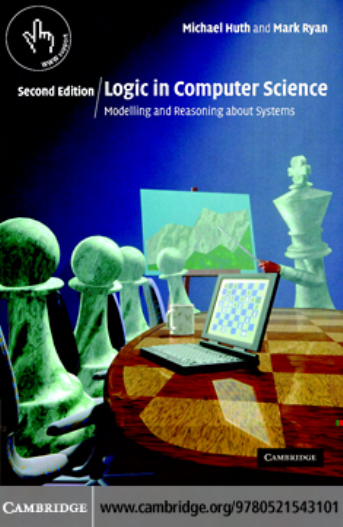
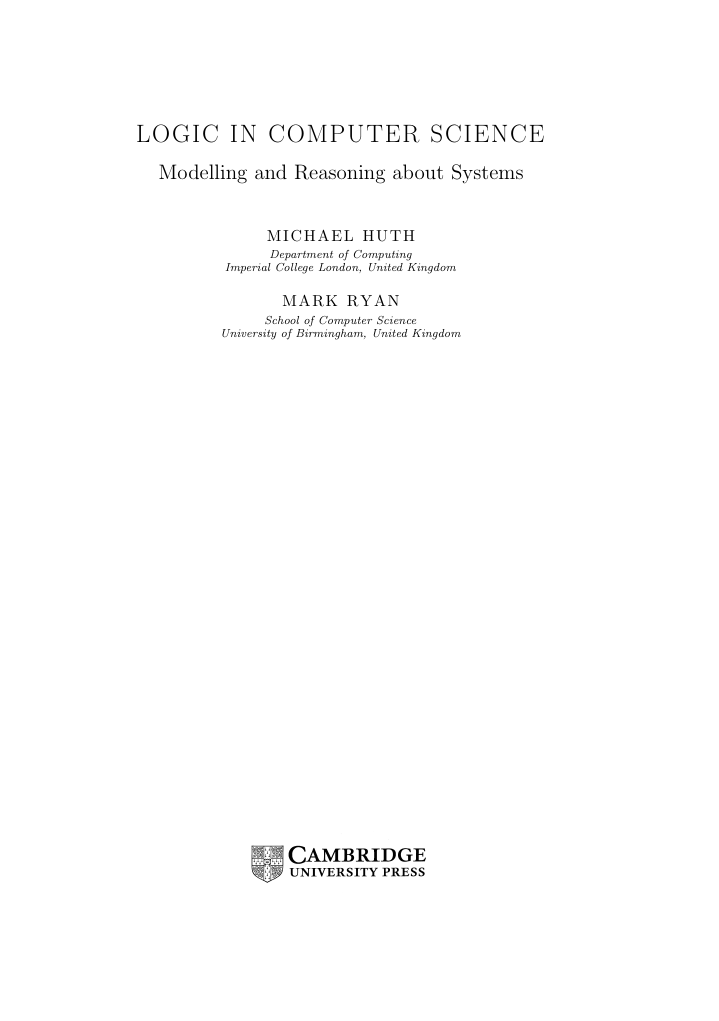
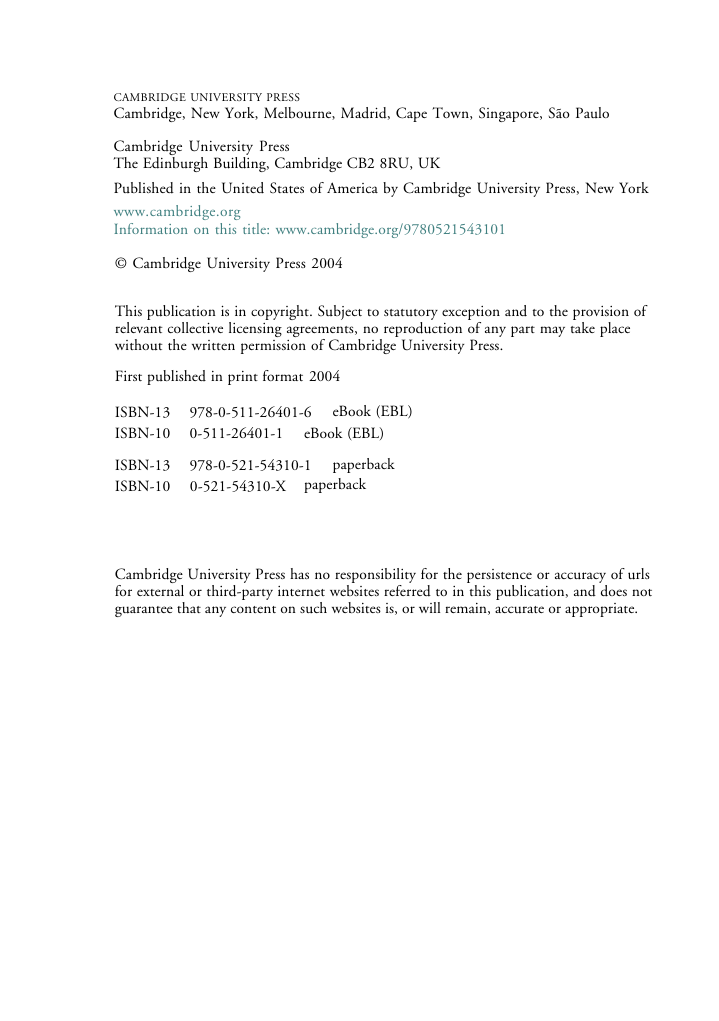
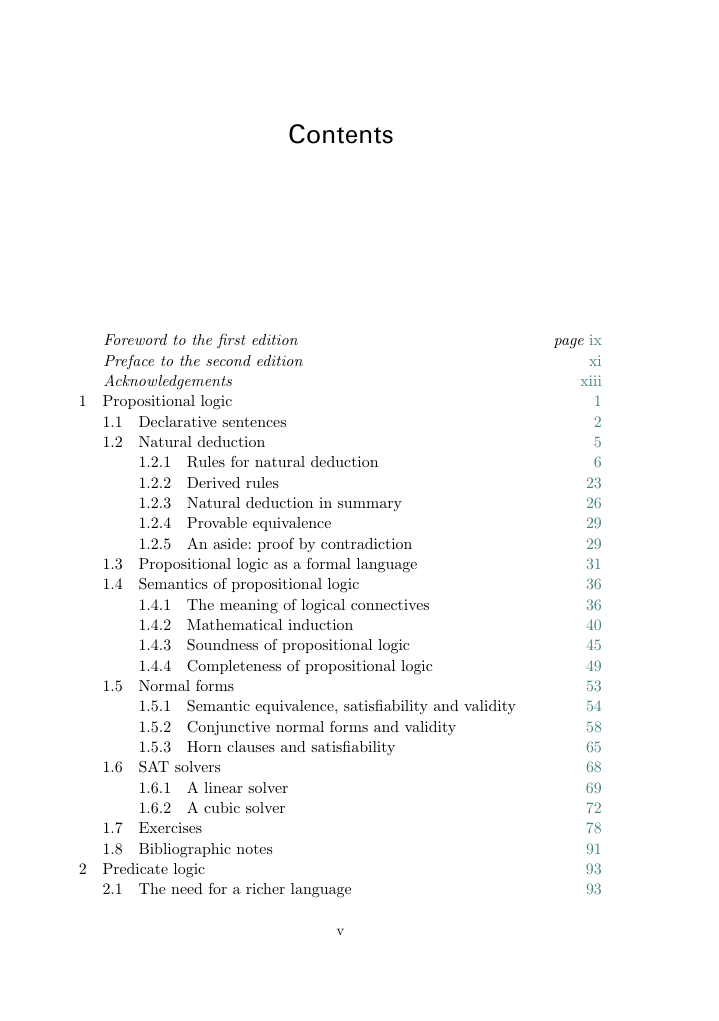

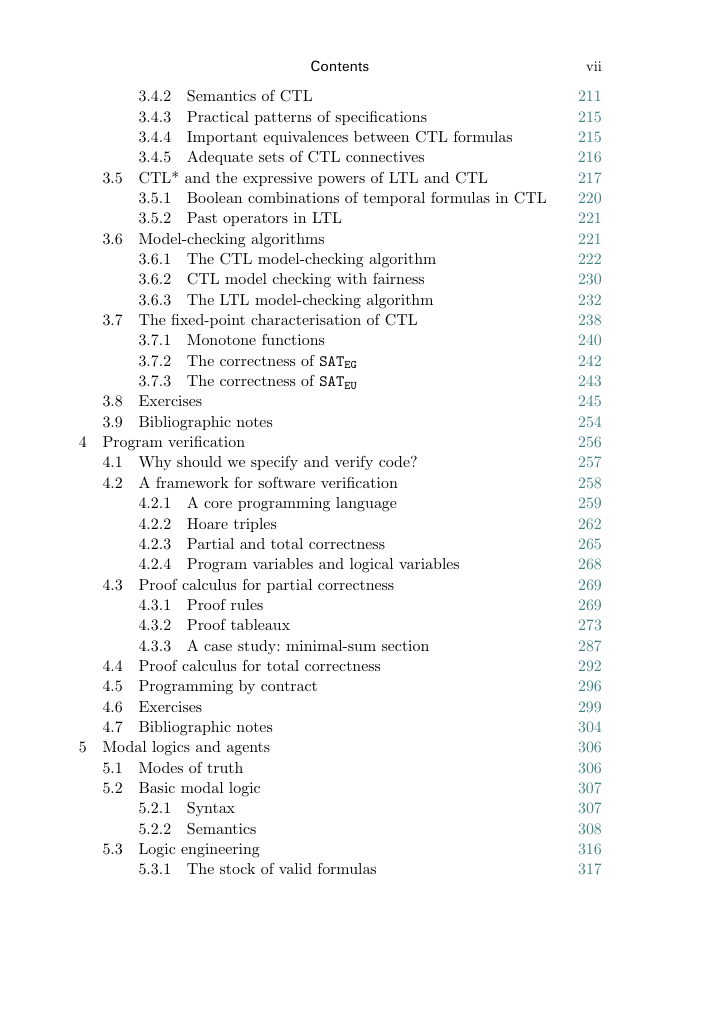
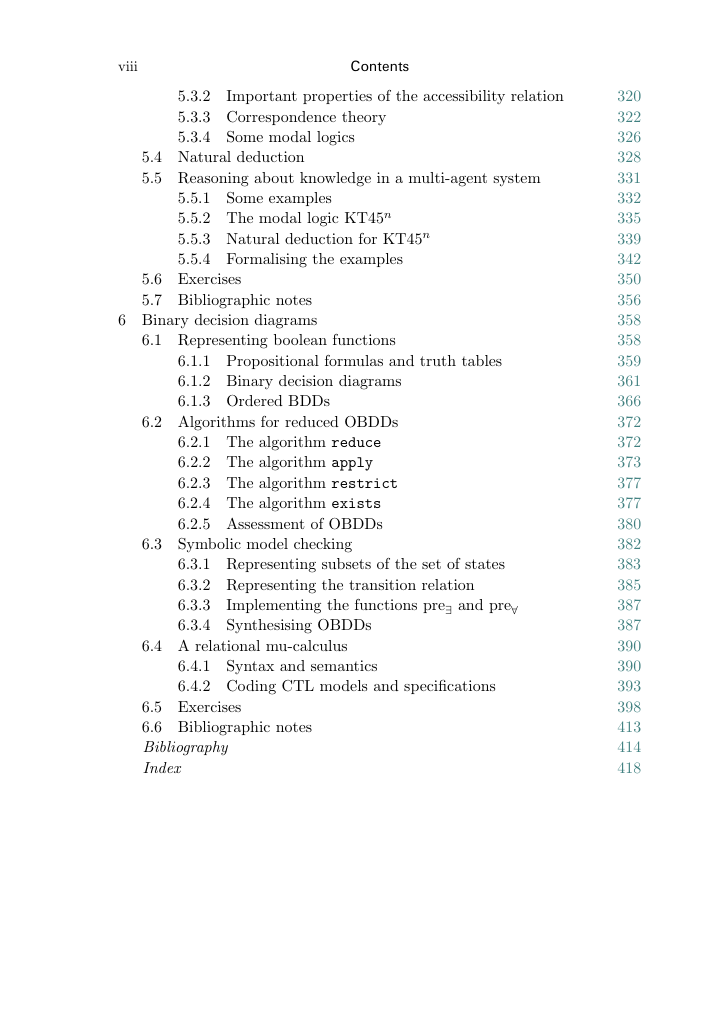
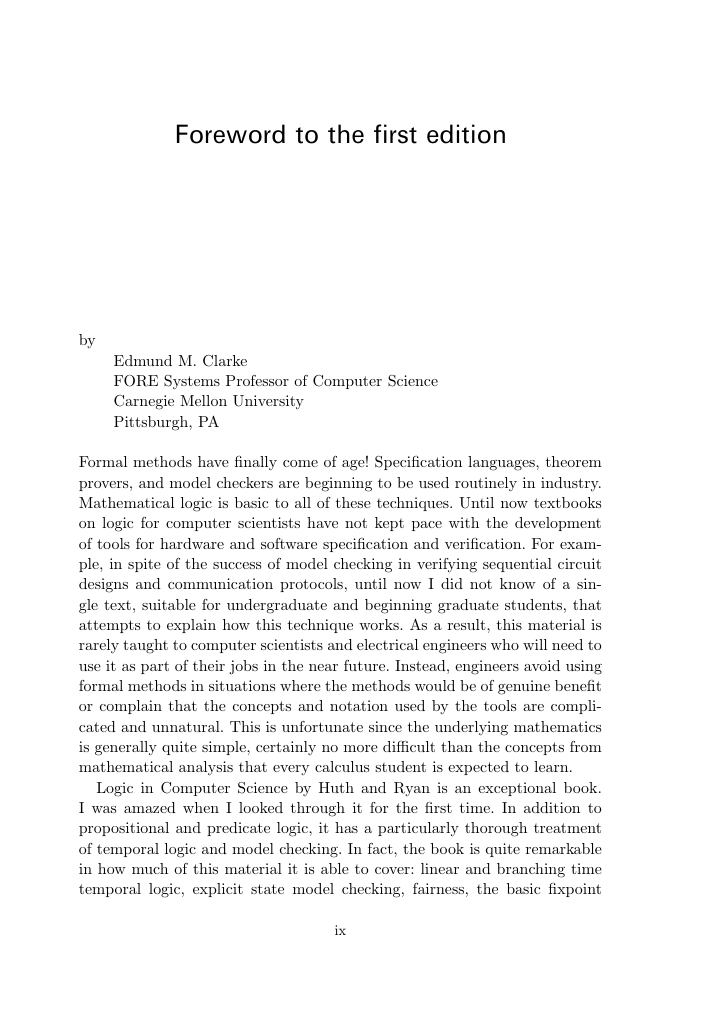








 2023年江西萍乡中考道德与法治真题及答案.doc
2023年江西萍乡中考道德与法治真题及答案.doc 2012年重庆南川中考生物真题及答案.doc
2012年重庆南川中考生物真题及答案.doc 2013年江西师范大学地理学综合及文艺理论基础考研真题.doc
2013年江西师范大学地理学综合及文艺理论基础考研真题.doc 2020年四川甘孜小升初语文真题及答案I卷.doc
2020年四川甘孜小升初语文真题及答案I卷.doc 2020年注册岩土工程师专业基础考试真题及答案.doc
2020年注册岩土工程师专业基础考试真题及答案.doc 2023-2024学年福建省厦门市九年级上学期数学月考试题及答案.doc
2023-2024学年福建省厦门市九年级上学期数学月考试题及答案.doc 2021-2022学年辽宁省沈阳市大东区九年级上学期语文期末试题及答案.doc
2021-2022学年辽宁省沈阳市大东区九年级上学期语文期末试题及答案.doc 2022-2023学年北京东城区初三第一学期物理期末试卷及答案.doc
2022-2023学年北京东城区初三第一学期物理期末试卷及答案.doc 2018上半年江西教师资格初中地理学科知识与教学能力真题及答案.doc
2018上半年江西教师资格初中地理学科知识与教学能力真题及答案.doc 2012年河北国家公务员申论考试真题及答案-省级.doc
2012年河北国家公务员申论考试真题及答案-省级.doc 2020-2021学年江苏省扬州市江都区邵樊片九年级上学期数学第一次质量检测试题及答案.doc
2020-2021学年江苏省扬州市江都区邵樊片九年级上学期数学第一次质量检测试题及答案.doc 2022下半年黑龙江教师资格证中学综合素质真题及答案.doc
2022下半年黑龙江教师资格证中学综合素质真题及答案.doc